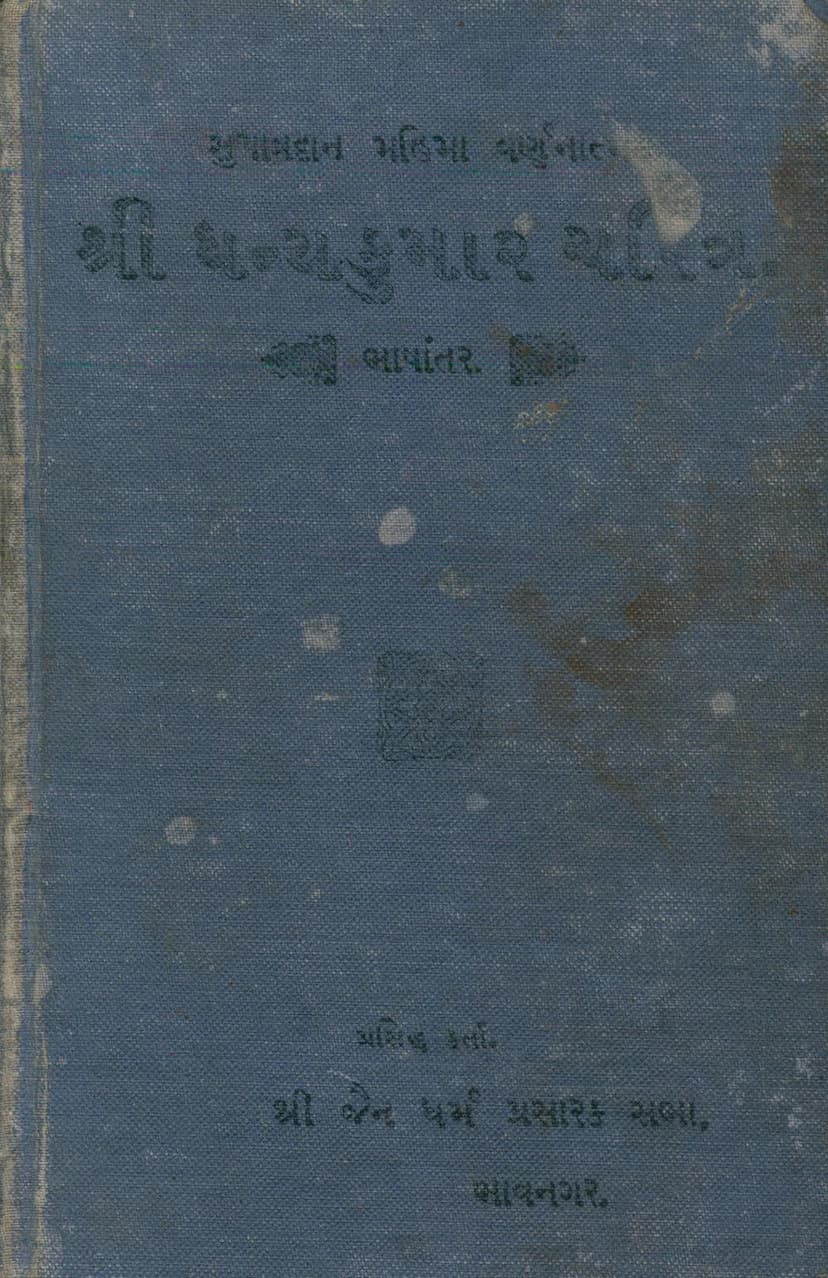Dhanyakumar Charitra Bhashantar
Added to library: September 1, 2025

Summary
This is a comprehensive summary of the Jain text "Dhanyakumar Charitra Bhashantar," authored by Gyansagar Gani and translated by Ratilal Girdharlal Kapadia, and published by Jain Dharm Prasarak Sabha.
Title: Dhanyakumar Charitra Bhashantar (Translation of the Life Story of Dhanyakumar)
Author(s): Gyansagar Gani (Original Author), Ratilal Girdharlal Kapadia (Translator)
Publisher: Jain Dharm Prasarak Sabha, Bhavnagar
Publication Date: Samvat 1978 (1922 CE), Veer Samvat 2448
Core Theme: The text emphasizes the supreme importance of Supatra Daan (charitable giving to worthy recipients) in Jainism, highlighting its virtues and the ultimate benefits it bestows, including spiritual progress and liberation (Moksha).
Summary of Key Content:
The book is essentially a prose translation of the life story of Dhanyakumar, which is presented as an example to illustrate the glory and significance of Supatra Daan. The text delves into the following aspects:
- The Paramountcy of Dharma: The introduction strongly emphasizes that Dharma (righteousness) is the primary auspicious factor in life, leading to heavenly pleasures and ultimate liberation. It quotes Mahatma Hemchandracharya's praise for Dharma, likening it to a mother, father, friend, relative, and teacher, all in one, bestowing spiritual growth, knowledge, peace, penance, and ultimate salvation.
2' The Four Pillars of Dharma: The text elaborates on the four foundational aspects of Dharma as described by the scriptures: * Daan (Charity): Giving what one has to deserving beings with a pure heart, without expecting any return. * Sheel (Virtue/Chastity): Reducing attachment to worldly pleasures, cultivating self-control, adhering to high moral principles, practicing restraint in worldly matters, and completely abstaining from illicit relations. * Tapa (Austerities): Performing penances to burn away karmic particles attached to the soul, without any regret or distress, to the best of one's ability from the prescribed twelve types of austerities. * Bhav (Mental State/Devotion): Being diligent in religious practices, controlling the senses, focusing the mind on spirituality and religious observances, and practicing one-pointedness.
-
The Primacy of Daan (Charity): The text argues that Daan is the foremost among these four pillars. While Sheel, Tapa, and Bhav primarily benefit the individual practicing them, Daan yields a dual benefit, bringing joy and fulfillment to both the giver and the receiver. Daan is presented as the most powerful means to overcome greed, the enemy of worldly beings.
-
Types of Daan: The text outlines five types of Daan:
- Abhaydaan (Fearlessness): Non-violence in thought, word, and deed; not causing distress to any living being; not speaking or acting in ways that cause agitation; maintaining a demeanor that inspires affection and dispels fear. This is considered the highest form of Daan.
- Supaatra Daan (Giving to the Worthy): Providing necessary items to deserving individuals at the right time to aid their spiritual practices and sustenance. This is also considered an excellent form of Daan, leading to worldly and spiritual prosperity, and ultimately Moksha.
- Anukampa Daan (Compassionate Giving): Giving desired items to the distressed, weak, suffering, helpless, or those with diminished resources out of compassion.
- Uchit Daan (Appropriate Giving): Giving to relatives, the needy, or those in need out of a sense of duty.
- Keerti Daan (Fame-Seeking Giving): Giving with the intention of gaining fame, praise, or recognition. This last type of Daan is stated to have only worldly benefits.
-
The Story of Dhanyakumar: The majority of the text is dedicated to the life of Dhanyakumar, a pious and virtuous individual who achieves immense wealth and prosperity through his righteousness and, crucially, through his unwavering commitment to Supaatra Daan.
- Early Life and Business Acumen: Dhanyakumar, the youngest of four brothers, possesses exceptional skills and intelligence from birth. Despite his brothers' jealousy, his virtue and business acumen lead to immense wealth.
- Acts of Generosity: The narrative details numerous instances of Dhanyakumar's generosity, particularly his Supaatra Daan. He consistently provides for the needy, the virtuous, and the spiritually inclined.
- Overcoming Obstacles: The story highlights Dhanyakumar's resilience and faith in Dharma even amidst challenges, such as his brothers' envy, attempts to undermine him, and the adverse circumstances caused by his father's downfall.
- Spiritual Journey: Dhanyakumar's life is portrayed as a journey of spiritual growth, marked by his adherence to Jain principles and his exemplary charity.
- The Story of Shalibhadra: The narrative also incorporates the story of Shalibhadra, presented as a parallel or complementary example of virtue and spiritual merit.
-
The Translator's Note and Memorial: The preface and other sections reveal that the book is a translation of an original work by Gyansagar Gani. Sadly, the translator, Ratilal Girdharlal Kapadia, passed away before completing the translation. His elder brother, Nemchand Girdharlal Kapadia, completed the work as a memorial to him. The book's publication is also supported by contributions from prominent Jain figures.
-
Philosophical Underpinnings: The text subtly weaves in Jain philosophical concepts like karma, the impermanence of wealth, and the importance of righteous conduct. The detailed index (Anukramanika) highlights the structured narrative, divided into nine "Pallavas" (chapters or sections), each focusing on different aspects of Dhanyakumar's life and the principles of Daan.
Overall Significance:
"Dhanyakumar Charitra Bhashantar" serves as a devotional and instructive text within Jainism, aiming to inspire readers to embrace the virtue of charity, particularly towards the deserving. It uses the exemplary life of Dhanyakumar to demonstrate that adherence to Dharma, especially through acts of generosity, leads to both worldly prosperity and ultimate spiritual liberation. The narrative is rich with moral lessons, illustrating the consequences of virtuous actions and the spiritual rewards they bring. The book's creation as a memorial also adds a layer of personal dedication and community effort to its publication.